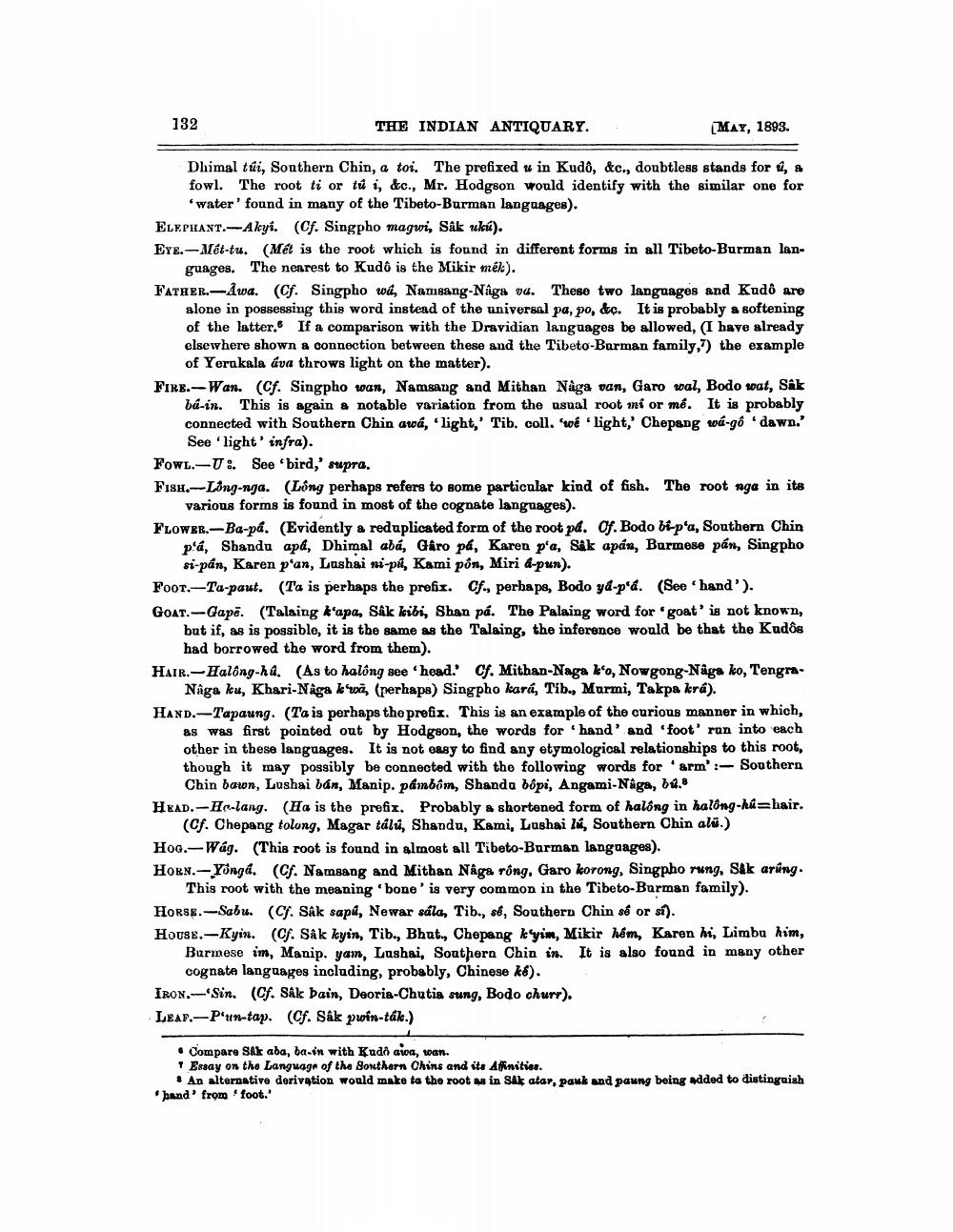________________
132
THE INDIAN ANTIQUARY.
MAY, 1893.
Dhimal túi, Southern Chin, a toi. The prefixed u in Kudo, &c., doubtless stands for u, a fowl. The root ti or tú i, &c., Mr. Hodgson would identify with the similar one for
'water' found in many of the Tibeto-Burman languages). ELEPHANT.-Akyi. (Cf. Singpho magwi, Sâk uku). Eye.--Mét-tu. (Met is the root which is found in different forms in all Tibeto-Burman lan
guages. The nearest to Kudô is the Mikir mek). FATHER.-Awa. (Cf. Singpho wi, Namsang-Naga ou. These two languages and Kudô are
alone in possessing this word instead of the universal pa, po, &c. It is probably a softening of the latter. If a comparison with the Dravidian languages be allowed, (I have already elsewhere shown a connection between these and the Tibeto-Barman family,7) the example
of Yerukala áva throws light on the matter). FIRE.-Wan. (Cf. Singpho wan, Namsang and Mithan Naga van, Garo wal, Bodo wat, Sak
bá-in. This is again a notable variation from the usual root ni or me. It is probably connected with Southern Chin awá, light,' Tib. coll. 'we light, Chepang wa-gô 'dawn.'
See 'light' infra). Fowl.-U.. See 'bird,' supra. Fish.-Long-nga. (Lông perhaps refers to some particular kind of fish. The root nga in its
various forms is found in most of the cognate languages). FLOWER.-Ba-pá. (Evidently a reduplicated form of the root pd. Of. Bodo bf-p'a, Southern Chin
piá, Shandu apá, Dhimal abá, Giro pá, Karen pa, Såk apán, Burmese pán, Singpho
si-pán, Karen p'an, Lashai ni-pi, Kami pón, Miri d-pun). Foot.-Ta-paut. (Ta is perhaps the prefix. Cf, perhaps, Bodo yd-pa. (See 'hand'). Goat.-Gapë. (Talaing kapa, Säk kibi, Shan pa. The Palaing word for goat' is not known,
but if, as is possible, it is the same as the Talaing, the inference would be that the Kudos
had borrowed the word from them). Hair.-Halông-hd. (As to halóng see 'head' Cf. Mithan-Naga k'o, Nowgong-Någa ko, Tengra
Någa ku, Khari-Naga k'wi, (perhaps) Singpho kará, Tib., Murmi, Takpa krá). HAND.-Tapaung. (Ta is perhaps the prefix. This is an example of the curious manner in which,
as was first pointed out by Hodgson, the words for hand' and 'foot' run into each other in these languages. It is not easy to find any etymological relationships to this root, though it may possibly be connected with the following words for 'arm':- Southern
Chin bawn, Lushai bán, Manip. pámbóm, Shanda bôpi, Angami-Naga, 64.8 HEAD.-Ho-lang. (Ha is the prefix. Probably & shortened form of halong in halông-hi=hair.
(Cf. Chepang tolong, Magar talu, Shandu, Kami, Lushai lú, Southern Chin alü.) Hog.-Wág. (This root is found in almost all Tibeto-Burman languages). HotNe-Yoga. (Cf. NamBang &nd Mikhan Nêga rồng, Garo korong, Singpho swag, Sak arứng.
This root with the meaning 'bone' is very common in the Tibeto-Burman family). HORSE.-Sabu. (Cf. Sak sapi, Newar sála, Tib., sé, Southern Chin sé or s). House.-Kyin. (Cf. SAk kyin, Tib., Bhat., Chepang k'yim, Mikir hâm, Karen Mi, Limbu him,
Burmese im, Manip. yam, Lushai, Southern Chin in. It is also found in many other
cognate languages including, probably, Chinese kl). IRON.---'Sin. (Cf. Sak bain, Deoria-Chutia sung, Bodo churr). LEAF.- Pun-tap. (Cf. Såk pwin-ták.)
. Compare Sak aba, ba-in with Kudô awa, wan.
Essay on the Language of the Southern Chins and its Affinities. : An alternative derivation would make to the root as in sak atar, pauk and paung being added to distinguish hand' from foot.'




